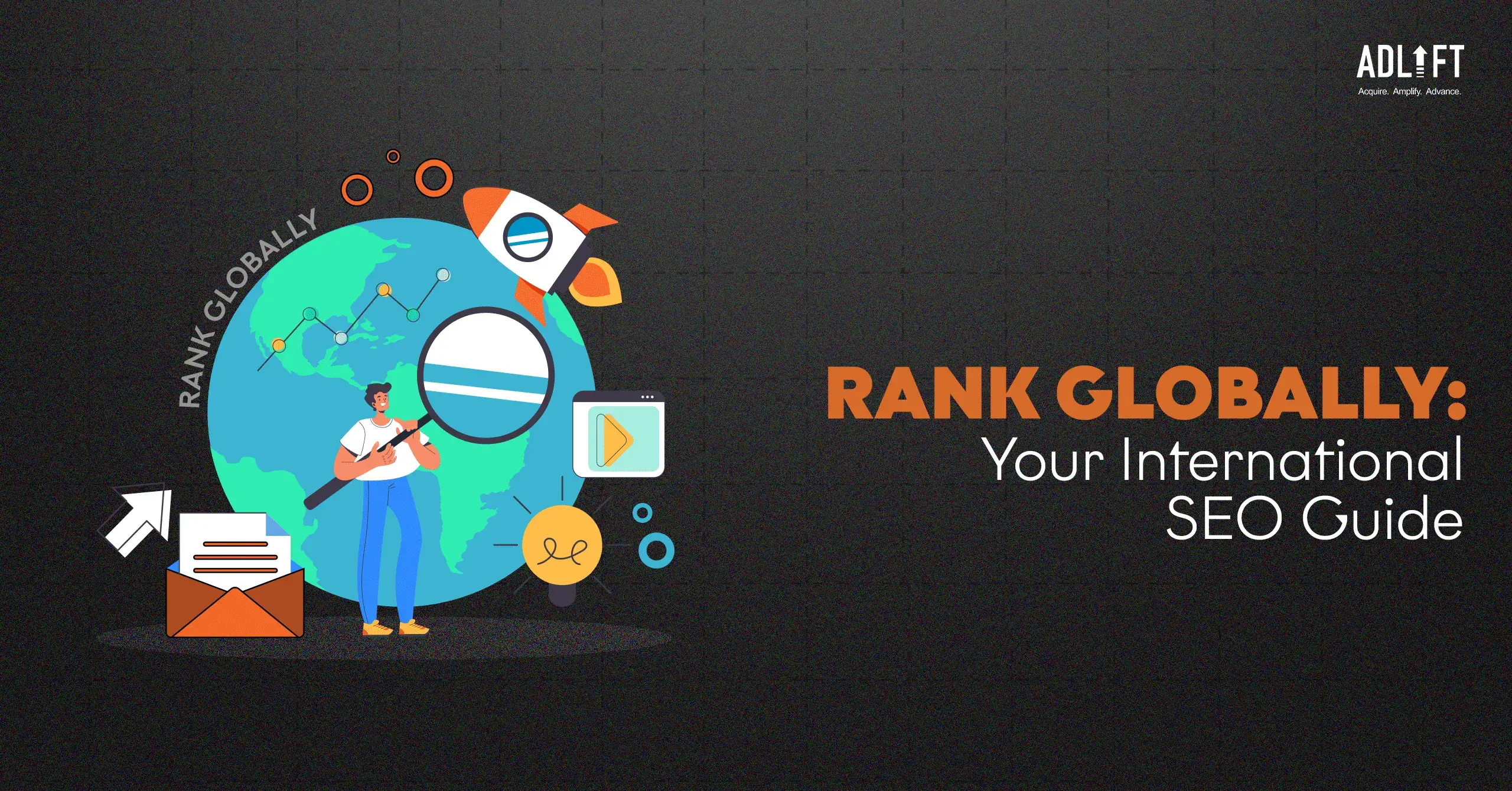Rank Globally: Your International SEO Strategies Guide

Get your International SEO Marketing right with AdLift
The internet has broken geographical barriers, transforming how businesses operate. Today, your local art gallery can potentially connect with art enthusiasts across the globe with just a few clicks. But with a world overflowing with international content, how do you ensure your gallery stands out in search results for that coveted piece or up-and-coming artist? This is where international SEO strategies come into play.
International SEO strategies go beyond traditional SEO, optimizing your gallery’s website for search engines in different countries and languages. It’s the key to unlocking the potential of international targeting and reaching a wider audience of collectors and art lovers. Imagine your gallery’s website appearing at the top of search results when someone in Paris searches for “impressionist paintings” or a potential collector in Japan looks for a specific artist. With a well-planned international SEO strategy, this dream can become a reality.
Many businesses, large and small, struggle with the question of how to do international SEO. Whether you’re considering working with an international SEO agency or tackling it yourself, there are effective strategies to understand the complexities of SEO for international markets. This blog post will be your guide, packed with international SEO strategies and techniques for mastering SEO for multiple countries. So whether you are that local art gallery or a Fortune 500 company, discover the reach of global SEO platforms and uncover your business’s potential.
Throughout this blog, we will discuss our work with Schneider Electric. As Schneider Electric’s SEO agency, we implemented a comprehensive international SEO strategy that increased the global company’s organic visibility by 65%!
How to do International SEO
Market Research
Identifying Your Target Markets:
- Language: People search differently depending on their language. Understanding the linguistic nuances of your target market ensures your content resonates and ranks well in international SEO.
- Region: Search trends and user behavior can vary significantly across regions. Tailoring your approach to each region will maximize your reach.
- Search Trends: Understand what your target audience is actively searching for. Utilize global SEO platform tools like SEMrush or Ahrefs to identify popular search terms in different languages. These tools provide great insights into search volume, competition, and related keywords to inform your content strategy.
Local Search Engines and User Search Patterns
Once you’ve completed keyword research, you must analyze how users search and the different search engines they use in your target countries.
For example, if a U.S. company expands into Germany and Brazil, it’s important to understand how local users search for products and services. Do they search in English, German, Portuguese, or a combination of these languages?
Additionally, Google is not the only search engine in use worldwide. In South Korea, Naver holds a significant portion of the search engine market. In China, the preferred search engine is Baidu, and in Russia, Yandex is the most popular choice.
Why is this important? When expanding into Russia and aiming to rank well on Yandex, you should be aware that Yandex might use different criteria for ranking. Yandex heavily relies on user behavior signals to determine site quality. Moreover, setting the correct region in Yandex’s Webmaster Tools is crucial to ensure your content is shown to the right audience in the appropriate geographical area.
What we did for Schneider Electric
Website Audit
Before planning your international SEO strategies, ensure your website is built for global success. Conduct a technical SEO audit to identify any potential roadblocks:
- Mobile Responsiveness: A website that adapts seamlessly across different screen sizes is crucial, especially with a large portion of searches happening on mobile devices. International SEO agencies often emphasize this during consultations – as it is one of the crucial aspects of international SEO.
- Page Speed: Nobody likes a slow website. Ensure your website loads quickly across various internet connection speeds, especially in regions where high-speed internet may not be accessible.
- Clean & Structured Architecture: A well-organized website with a clear hierarchy is essential for both users and search engines, thereby making it easier for content to be crawled and indexed.
With a solid understanding of your target markets and a technical foundation in place, you’re ready to take the next step!
Get Your International SEO Audit Now!
Technical International Search Engine Optimization
URL Structure
Clear and internationalized domain names (IDNs) or subfolders for different languages are crucial for a great international SEO strategy. Here’s why:
- Clarity for Users: Users understand the language and targeting of a webpage based on the URL structure.
- Search Engine Friendliness: International SEO platforms can easily understand the website’s language targeting with a proper URL structure.
Examples of Effective URL Structures:
- India: https://www.se.com/in/en/
- Brazil: https://www.se.com/br/pt/
- France: https://www.se.com/fr/fr/
Country Code Top-Level Domains (ccTLDs): yourcompany.fr for France, yourcompany.de for Germany.
Subdirectories: yourcompany.com/fr/ for France, yourcompany.com/de/ for Germany.
Hreflang Tags
Hreflang tags are a critical component of technical international SEO. They signal search engines about the targeted languages and regions of your website content.
Here’s how they work:
Imagine you have a page about “sustainability” that you’ve translated into French and Spanish. You would add Hreflang tags to each webpage to specify the targeted language and region. Here’s an example:
<link rel="alternate" href="https://www.se.com/uk/en/about-us/sustainability/" hreflang="en-gb" />
<link rel="alternate" href="https://www.se.com/mx/es/about-us/sustainability/" hreflang="es-mx" />
<link rel="alternate" href="https://www.se.com/pt/pt/about-us/sustainability/" hreflang="pt-pt" />Best Practices for Hreflang Tags:
- Ensure accuracy: Specify the correct language and region for each version of your webpage.
- Use consistent formatting: Maintain a consistent structure for your Hreflang tags across all webpages.
- Include all language variations: Specify all language versions of your webpage in the Hreflang tags.
Website Localization
Website localization takes international SEO a step further by adapting your website’s content and its functions to specific cultural contexts of your target market. Here are some best practices when you are planning your international targeting or SEO for multiple countries:
- Currency Conversion: Display prices and costs in the local currency of your target audience.
- Date and Time Formatting: Adjust dates and times to the format commonly used in your target region (e.g., DD/MM/YYYY vs. MM/DD/YYYY).
- Measurement Units: Adapt measurements to the local system (e.g., kilometers vs. miles, Celsius vs. Fahrenheit).
- Legal Compliance: Ensure your website adheres to local legal requirements and local regulations such as data privacy laws.
Content Optimization for SEO for Global Markets
Keyword Research and Targeting
Keyword research is the basis of any SEO strategy, but for SEO for international markets it’s crucial to conduct research specific to each target language and market. Here’s why:
- Search Intent: People search for things differently depending on location and language. Understanding local search intent helps you target relevant keywords.
- Long-Tail Keywords: International SEO often benefits from long-tail keywords, which are specific and do not have as much competition as broad keywords.
Here are some global SEO platform tools you can use for international keyword research:
- SEMrush
- Ahrefs
- Google Keyword Planner (with language settings)
Content Creation and Translation
Creating high-quality, culturally relevant content for each target audience is paramount for a successful international SEO strategy. Here’s what to consider when you are doing SEO for multiple countries:
- Cultural Relevance: Adapt your content to resonate with the cultural nuances of your target market. This might involve using local references, humor, and examples.
- High-Quality Content: Always prioritize high-quality relevant content that engages your audience and that your audience finds value in.
- Proper Translation: Don’t settle for literal translations! Hire professional translators or use translation tools that consider cultural context.
- Strategic Anchor Text: Localized content with relevant anchor texts for improved page authority and keyword ranking. Here is what we did for Schneider Electric:
Here are some options for content creation:
- Hire freelance translators with experience in your target market.
- Utilize translation management systems (TMS) for large-scale content translation.
- Use machine translation tools (with caution) as a starting point, but always edit and proofread for accuracy and cultural appropriateness.
Image Optimization
Images are a powerful tool for engagement, but they also play a role in international SEO. Here’s why image optimization matters:
- Localized Alt Text: Use alt text that is descriptive and relevant to the target language. By doing this, you help search engines understand the image content and improve user experience for those using screen readers.
- Culturally Appropriate Images: Avoid using imagery that might be offensive or confusing in certain cultures.
Building Backlinks for International Targeting
Backlinks are links that come from other websites to your website. They are a crucial factor in a robust international SEO strategy, signaling to search engines that your website is trustworthy and authoritative. Building backlinks from websites in your target markets is especially important when implementing SEO for multiple countries.
Here’s why backlinks matter:
- Increased Website Authority: Backlinks from high-quality websites in your target market can significantly boost your website’s authority in the eyes of search engines.
- Improved Search Ranking: Those websites that have higher authority generally tend to rank higher in search engine results pages.
Strategies for Building Backlinks:
- Guest Blogging: Write informative guest blog posts for relevant websites in your target languages. Ensure the websites have good domain authority and are relevant to your industry.
- Broken Link Building: Look for broken links on relevant websites in your target market and suggest your high-quality content as a replacement.
- Industry Awards and Recognition: Winning awards or being recognized by reputable organizations in your target market can lead to backlinks from industry publications.
- Multi-lingual Backlinks: Building backlinks from high-authority websites in your target languages, with content relevant to those languages, is a powerful international SEO strategy that strengthens your website’s multilingual authority and visibility in those specific markets.
Here’s what we did for Schneider Electric:
Remember, building backlinks takes time and effort.
By following these steps, you can create a solid foundation for your international SEO strategy. Remember, international SEO agencies can provide valuable expertise and support throughout the process.
Get
in Touch
Contact AdLift for a 360-degree marketing plan
FAQs
I’m interested in expanding my business globally. How can international SEO strategies help?
International SEO makes sure your website ranks higher in search results for users belonging to different countries. This increases your visibility to potential customers worldwide and drives qualified traffic to your site.
What are some key considerations for international targeting in SEO?
International targeting involves optimizing your website for specific regions or languages. This might involve using relevant keywords, translating content, and building backlinks from sites in those target markets.
Should I consider hiring an international SEO agency?
While it’s tempting to do SEO for multiple countries after reading an informative blog like this, an international SEO agency can be a valuable asset, especially if you’re new to this area. An agency can help you create a robust strategy, conduct keyword research for various markets, and navigate the complexities of global SEO platforms.
How do I get started with international SEO?
There are many resources available to help you with SEO for international markets. Start by researching international SEO tips and best practices. There are also tools and platforms specifically designed to help manage SEO for multiple countries.
What are some practical international SEO tips I can implement right away?
Here are a few quick tips:
- Conduct keyword research in your target languages.
- Translate your website content to relevant languages and optimize it for local search engines.
- Use hreflang tags to specify your website’s language and target audience.
- Build backlinks from websites in your target countries.
Categories
- AI
- ChatGPT
- Content Marketing
- Content Marketing & Strategy
- Digital Marketing
- Entrepreneurship
- Google Analytics
- Google Tag Manager
- Google Updates
- Influencer Marketing
- Mobile App Marketing
- Paid Marketing
- Press
- Pubcon
- Search Engine Marketing
- Search Engine Optimization
- SEO
- SEO Tools
- Social Media Marketing
Recent Posts
- How do I Verify My Business on Google to Ace Local SEO? March 17, 2025
- The Pros and Cons of Pay For Performance SEO March 17, 2025
- Website Structure for SEO: A Blueprint for Better Rankings March 17, 2025
- Keyword Cannibalization: Why It Matters for Your Company and How to Avoid It March 12, 2025
- SEO for Bing: Unlocking Opportunities for Business Owners and Marketers March 11, 2025
- Google Cached Websites: A Quick Guide to Accessing Them March 5, 2025
- Programmatic Advertising: Stop Just Talking About It, and Start Driving Real Growth (A Business Leader’s Guide to Cutting Through the Hype) March 4, 2025
- How to Use Google Trends: The Ultimate Guide for SEO & Content Marketers March 4, 2025
- Farewell, Skype: It’s the End of an Era March 3, 2025
- How to Plan and Execute a Website Migration Without Losing Rankings? February 28, 2025










